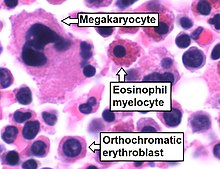Structure

The composition of marrow is dynamic, as the mixture of cellular and non-cellular components (connective tissue) shifts with age and in response to systemic factors. In humans, marrow is colloquially characterized as "red" or "yellow" marrow (Latin: medulla ossium rubra, Latin: medulla ossium flava, respectively) depending on the prevalence of hematopoietic cells vs fat cells. While the precise mechanisms underlying marrow regulation are not understood, compositional changes occur according to stereotypical patterns. For example, a newborn baby's bones exclusively contain hematopoietically active "red" marrow, and there is a progressive conversion towards "yellow" marrow with age. In adults, red marrow is found mainly in the central skeleton, such as the pelvis, sternum, cranium, ribs, vertebrae and scapulae, and variably found in the proximal epiphyseal ends of long bones such as the femur and humerus. In circumstances of chronic hypoxia, the body can convert yellow marrow back to red marrow to increase blood cell production.
Hematopoietic componentsedit
At the cellular level, the main functional component of bone marrow includes the progenitor cells which are destined to mature into blood and lymphoid cells. Marrow contains hematopoietic stem cells which give rise to the three classes of blood cells that are found in circulation: white blood cells (leukocytes), red blood cells (erythrocytes), and platelets (thrombocytes).
| Group | Cell type | Average fraction |
Reference range |
|---|---|---|---|
| Myelopoietic cells |
Myeloblasts | 0.9% | 0.2–1.5 |
| Promyelocytes | 3.3% | 2.1–4.1 | |
| Neutrophilic myelocytes | 12.7% | 8.2–15.7 | |
| Eosinophilic myelocytes | 0.8% | 0.2–1.3 | |
| Neutrophilic metamyelocytes | 15.9% | 9.6–24.6 | |
| Eosinophilic metamyelocytes | 1.2% | 0.4–2.2 | |
| Neutrophilic band cells | 12.4% | 9.5–15.3 | |
| Eosinophilic band cells | 0.9% | 0.2–2.4 | |
| Segmented neutrophils | 7.4% | 6.0–12.0 | |
| Segmented eosinophils | 0.5% | 0.0–1.3 | |
| Segmented basophils and mast cells | 0.1% | 0.0–0.2 | |
| Erythropoietic cells |
Pronormoblasts | 0.6% | 0.2–1.3 |
| Basophilic normoblasts | 1.4% | 0.5–2.4 | |
| Polychromatic normoblasts | 21.6% | 17.9–29.2 | |
| Orthochromatic normoblast | 2.0% | 0.4–4.6 | |
| Other cell types |
Megakaryocytes | < 0.1% | 0.0-0.4 |
| Plasma cells | 1.3% | 0.4-3.9 | |
| Reticular cells | 0.3% | 0.0-0.9 | |
| Lymphocytes | 16.2% | 11.1-23.2 | |
| Monocytes | 0.3% | 0.0-0.8 |
Stromaedit
The stroma of the bone marrow includes all tissue not directly involved in the marrow's primary function of hematopoiesis. Stromal cells may be indirectly involved in hematopoiesis, providing a microenvironment that influences the function and differentiation of hematopoietic cells. For instance, they generate colony stimulating factors, which have a significant effect on hematopoiesis. Cell types that constitute the bone marrow stroma include:
- fibroblasts (reticular connective tissue)
- macrophages, which contribute especially to red blood cell production, as they deliver iron for hemoglobin production.
- adipocytes (fat cells)
- osteoblasts (synthesize bone)
- osteoclasts (resorb bone)
- endothelial cells, which form the sinusoids. These derive from endothelial stem cells, which are also present in the bone marrow.
Comments
Post a Comment